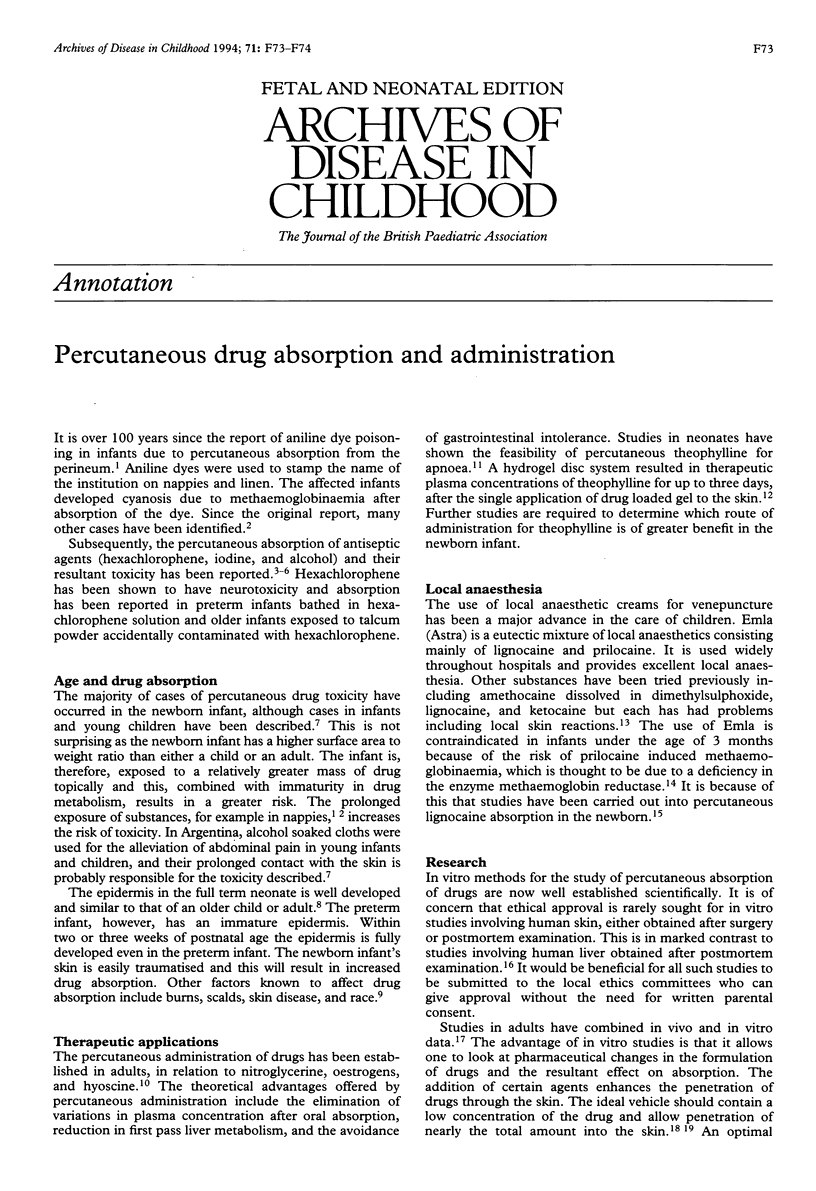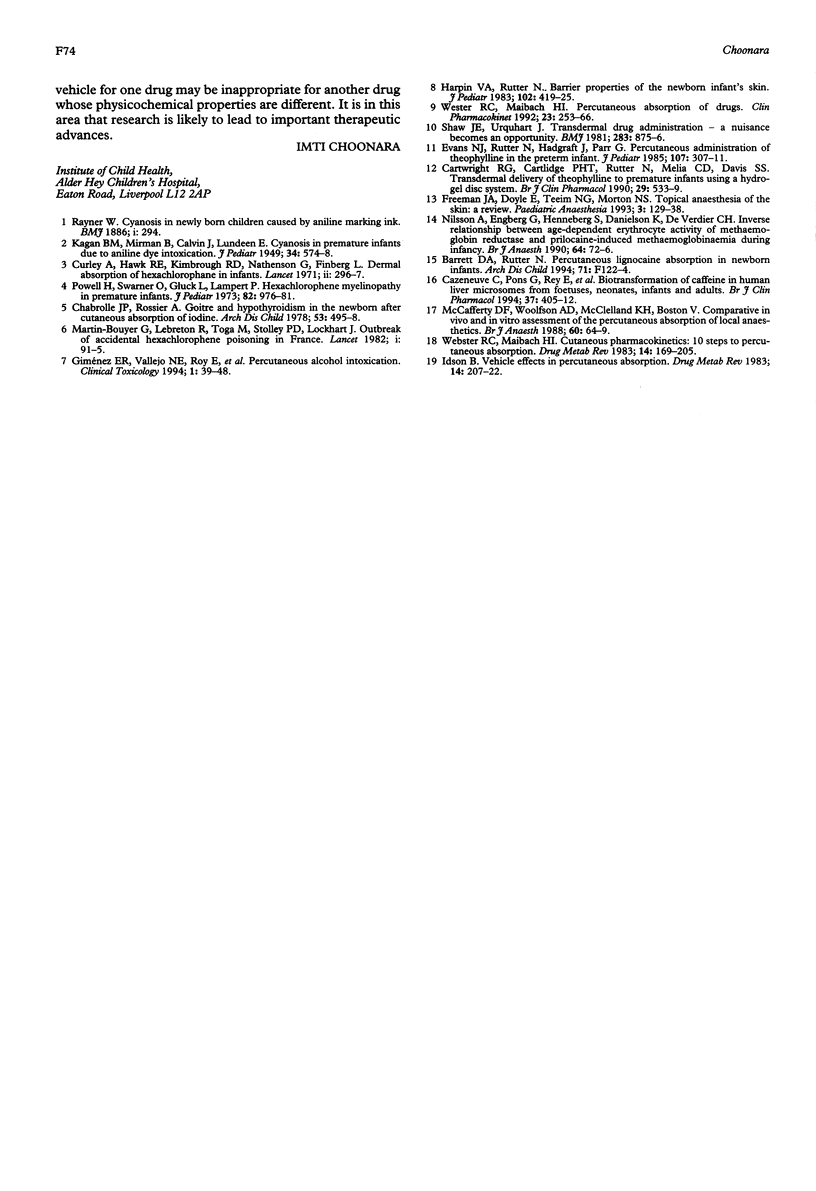Full text
PDF

Selected References
These references are in PubMed. This may not be the complete list of references from this article.
- Barrett D. A., Rutter N. Percutaneous lignocaine absorption in newborn infants. Arch Dis Child. 1994 Sep;71(2):F122–F124. doi: 10.1136/fn.71.2.f122. [DOI] [PMC free article] [PubMed] [Google Scholar]
- Cartwright R. G., Cartlidge P. H., Rutter N., Melia C. D., Davis S. S. Transdermal delivery of theophylline to premature infants using a hydrogel disc system. Br J Clin Pharmacol. 1990 May;29(5):533–539. doi: 10.1111/j.1365-2125.1990.tb03676.x. [DOI] [PMC free article] [PubMed] [Google Scholar]
- Cazeneuve C., Pons G., Rey E., Treluyer J. M., Cresteil T., Thiroux G., D'Athis P., Olive G. Biotransformation of caffeine in human liver microsomes from foetuses, neonates, infants and adults. Br J Clin Pharmacol. 1994 May;37(5):405–412. doi: 10.1111/j.1365-2125.1994.tb05706.x. [DOI] [PMC free article] [PubMed] [Google Scholar]
- Chabrolle J. P., Rossier A. Goitre and hypothyroidism in the newborn after cutaneous absorption of iodine. Arch Dis Child. 1978 Jun;53(6):495–498. doi: 10.1136/adc.53.6.495. [DOI] [PMC free article] [PubMed] [Google Scholar]
- Curley A., Kimbrough R. D., Hawk R. E., Nathenson G., Finberg L. Dermal absorption of hexochlorophane in infants. Lancet. 1971 Aug 7;2(7719):296–297. doi: 10.1016/s0140-6736(71)91337-7. [DOI] [PubMed] [Google Scholar]
- Evans N. J., Rutter N., Hadgraft J., Parr G. Percutaneous administration of theophylline in the preterm infant. J Pediatr. 1985 Aug;107(2):307–311. doi: 10.1016/s0022-3476(85)80157-8. [DOI] [PubMed] [Google Scholar]
- Harpin V. A., Rutter N. Barrier properties of the newborn infant's skin. J Pediatr. 1983 Mar;102(3):419–425. doi: 10.1016/s0022-3476(83)80669-6. [DOI] [PubMed] [Google Scholar]
- Idson B. Vehicle effects in percutaneous absorption. Drug Metab Rev. 1983;14(2):207–222. doi: 10.3109/03602538308991389. [DOI] [PubMed] [Google Scholar]
- Martin-Bouyer G., Lebreton R., Toga M., Stolley P. D., Lockhart J. Outbreak of accidental hexachlorophene poisoning in France. Lancet. 1982 Jan 9;1(8263):91–95. doi: 10.1016/s0140-6736(82)90225-2. [DOI] [PubMed] [Google Scholar]
- McCafferty D. F., Woolfson A. D., McClelland K. H., Boston V. Comparative in vivo and in vitro assessment of the percutaneous absorption of local anaesthetics. Br J Anaesth. 1988 Jan;60(1):64–69. doi: 10.1093/bja/60.1.64. [DOI] [PubMed] [Google Scholar]
- Nilsson A., Engberg G., Henneberg S., Danielson K., De Verdier C. H. Inverse relationship between age-dependent erythrocyte activity of methaemoglobin reductase and prilocaine-induced methaemoglobinaemia during infancy. Br J Anaesth. 1990 Jan;64(1):72–76. doi: 10.1093/bja/64.1.72. [DOI] [PubMed] [Google Scholar]
- Powell H., Swarner O., Gluck L., Lampert P. Hexachlorophene myelinopathy in premature infants. J Pediatr. 1973 Jun;82(6):976–981. doi: 10.1016/s0022-3476(73)80428-7. [DOI] [PubMed] [Google Scholar]
- Shaw J. E., Urquhart J. Transdermal drug administration--a nuisance becomes an opportunity. Br Med J (Clin Res Ed) 1981 Oct 3;283(6296):875–876. doi: 10.1136/bmj.283.6296.875. [DOI] [PMC free article] [PubMed] [Google Scholar]
- Wester R. C., Maibach H. I. Cutaneous pharmacokinetics: 10 steps to percutaneous absorption. Drug Metab Rev. 1983;14(2):169–205. doi: 10.3109/03602538308991388. [DOI] [PubMed] [Google Scholar]
- Wester R. C., Maibach H. I. Percutaneous absorption of drugs. Clin Pharmacokinet. 1992 Oct;23(4):253–266. doi: 10.2165/00003088-199223040-00002. [DOI] [PubMed] [Google Scholar]


